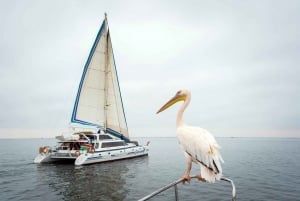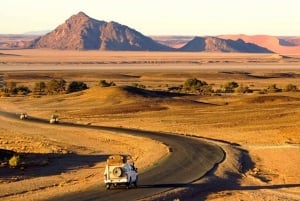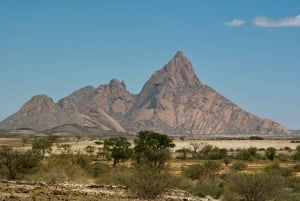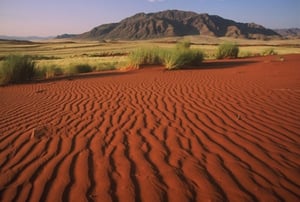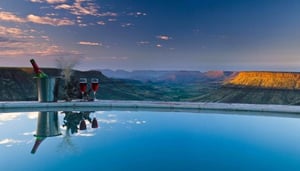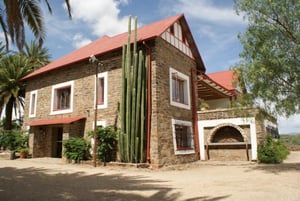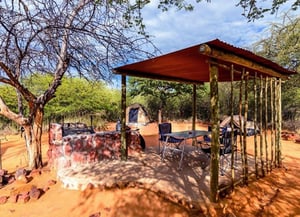Aranos
Aranos: The Gateway to the Kalahari Desert
Book Top Experiences and Tours in Namibia:
If youʻre booking your trip to Namibia last minute, we have you covered. Below are some of the top tours and experiences!- Windhoek: City and Township Tour
- Walvis Bay: Sandwich Harbour Sunset Tour
- Walvis Bay: Marine Big 5 Luxury Catamaran Tour
- Swakopmund: Desert Dunes Quad Biking with Optional Sandboard
- Etosha National Park: Full or Half-Day Game Drive
Aranos was originally established in the early 20th century as a settlement for settlers and farmers in the region. It quickly grew into an important administrative and commercial center for the surrounding agricultural areas. The town is named after the nearby Aranos River, which flows seasonally and plays a significant role in the region’s agriculture and wildlife.
Today, Aranos is primarily known for its proximity to the Kalahari Desert, one of the world’s most iconic and expansive deserts. Its location also makes it a key point of access for travelers heading to various national parks and wildlife reserves in southern Namibia and Botswana.
During Namibia’s colonial history, the area was primarily used for farming and livestock, with many of the indigenous people from the region, such as the Herero and Damara communities, contributing to the local culture. These indigenous groups have shaped the area’s heritage, and their influence can still be seen in local traditions, festivals, and art today.
Cultural Heritage and Traditions
The town of Aranos has a rich cultural diversity, with various ethnic groups contributing to its unique identity. While the town is predominantly home to Damara and Herero communities, there are also Nama and Khoi people in the surrounding areas. The blending of these cultural influences creates a lively and welcoming atmosphere, with many traditional customs still practiced by the locals.
Visitors to Aranos can experience traditional music and dance, such as the Herero dances, which are performed during special ceremonies and celebrations. Local artisans produce beautiful beaded jewelry, wood carvings, and woven crafts, which can be purchased at small craft markets around town. These items represent the heritage of the communities in Aranos and are a wonderful way to bring home a piece of local culture.
Natural Beauty and Surroundings
One of Aranos' greatest assets is its proximity to the Kalahari Desert, which offers stunning landscapes and a sense of adventure for those who love the outdoors. The Kalahari is famous for its sweeping dunes, dry riverbeds, and starkly beautiful environment. While the area surrounding Aranos is not as harsh as the core of the desert, it still provides a unique opportunity to explore the vast and arid beauty of the southern Namibian landscape.
For those looking to experience the Kalahari’s flora and fauna, nearby Kgalagadi Transfrontier Park (spanning Namibia and South Africa) is a haven for wildlife enthusiasts. This park is home to large populations of lions, cheetahs, springbok, and gemsbok, as well as a wide range of bird species. Game drives and guided tours provide visitors with an unforgettable safari experience in one of Southern Africa’s most iconic conservation areas.
In addition to the Kalahari, the Aranos River and surrounding wetlands offer an oasis of life in an otherwise dry environment. This area is a magnet for birdwatchers, with species such as yellow-billed kites, sociable weavers, and marsh harriers populating the skies. The landscape of Aranos is perfect for photography, as the interplay of sunlight, shadows, and desert features create breathtaking scenery.
Agriculture and Economy
The economy of Aranos has traditionally been driven by agriculture, with livestock farming being the backbone of the town’s economy. Many of the surrounding farms are involved in the production of cattle, sheep, and goats, while crop farming—especially maize and millet—also plays an important role. The region benefits from the arable lands and seasonal rains that allow for a strong agricultural presence.
In addition to farming, Aranos is known for its mineral resources, which include limestone, clay, and sandstone deposits. These resources have been used in construction and other industries, providing further economic growth and employment opportunities.
Aranos also has a growing service sector, with small shops, schools, and health facilities serving the local community. The town is becoming an increasingly important center for surrounding rural areas, offering a range of services that improve the quality of life for residents.
Access to Regional Adventures
Aranos serves as a key transit point for travelers heading to Botswana and the Kalahari Desert. Its location on the B1 road makes it easily accessible for those traveling to Ghanzi in Botswana, or for those making their way to the Kgalagadi Transfrontier Park. The town is also conveniently located for travelers wishing to explore other parts of southern Namibia, including Fish River Canyon and the Namib Desert.
Nearby towns such as Mariental and Keetmanshoop are within driving distance, offering additional opportunities for cultural exploration and nature experiences. The Fish River Canyon, located to the south, is one of the largest canyons in the world and offers breathtaking views and hiking opportunities.
For those interested in cross-border adventures, Botswana is easily accessible from Aranos, and travelers can visit destinations such as Maun, a gateway to the Okavango Delta, and the famous Moremi Game Reserve, renowned for its diverse wildlife and landscapes.
Conclusion
Aranos is a charming and scenic town with much to offer both locals and visitors. While it may not be one of Namibia’s most well-known tourist destinations, it provides an authentic experience of southern Namibia’s desert landscape, cultural heritage, and agricultural traditions. Whether you're seeking to explore the breathtaking beauty of the Kalahari Desert, enjoy a wildlife safari, or learn more about the indigenous cultures of the region, Aranos offers an enriching experience for travelers.
As the town continues to develop, Aranos holds great potential for tourism, agriculture, and regional trade. For those willing to venture off the beaten path, Aranos provides a unique and memorable glimpse into the heart of Namibia’s southern landscapes.






